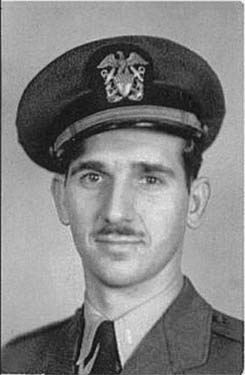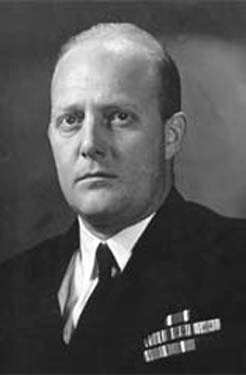|
Ensign Coit Butler and Lieutenant James Starr were part of an experienced special
fighter direction team that boarded the USS BUSH on January 27, 1945 for temporary duty.
|
|
 Ensign Coit Butler - 1945 |
 Lt. James Starr - Circa 1945 |
|
The Fighter Direction team consisted of Lt. James Starr (Senior Intercept Officer),
Coit Butler (Junior Intercept Officer) and Lt. (jg) John Gordon Foster.
Ensign Butler was a multi-engine pilot who elected to enter the Fighter Director training program. Lt. Starr and Ensign Butler underwent four months of training learning how to control and direct fighter planes to intercept enemy aircraft starting at least 50 miles out. Coit recalls, "Our job was to protect the fleet elements when underway or maintaining station to protect amphibious landing operations. A combat air patrol (CAP) of 4 or sometimes 8 fighters would be assigned to us for our control and direction. When incoming enemy planes were spotted on the radar we would give the CAP the course, altitude, and speed to fly to intercept them before they could reach their target. The ideal intercept put our fighters, their approach undetected, in a position to attack the enemy planes from above and behind on the same course." The two Fighter Intercept Officers (Lt. Starr and Coit) worked in CIC (Combat Information Center), which was located just aft of the pilothouse (bridge). Lt. (jg) Foster was specifically trained to maintain and operate the new SK (air search) radar. Recalling the SK radar, Coit notes this radar "for the fist time gave us an accurate altitude as well as distance and track of approaching planes. This radar was installed only on Radar Picket Destroyers." Three enlisted men also reported aboard ship for temporary duty in connection with fighter direction. The enlisted men reporting a few days prior to Lt. Starr and Ensigns Butler and Foster were Joel E. King - RdM3c; Wilbur L. Mulvaney - RM3c; and Byron M. McCarthy - RdM2c. These radarmen were specially trained for the new SK air search radar. |
|
|
All six of these temporarily assigned men were still aboard the USS BUSH when the ship was lost on April 6, 1945. All survived the attack that claimed BUSH, except for Lt. (jg) John Foster and RdM2c Byron McCarthy. Though BUSH deck logs record just these six men as being aboard ship for fighter direction activity, many others participated in this important job. Coit notes "the Bush radarmen in the CIC were part of the working team .... everyone was involved in maintaining and operating all the radio and internal communication equipment, and the several radars -- surface, air, and fire control. In addition there were the plotters that marked the target tracks and info on the plotting and status boards." The entire Fighter Direction Team really did good work on the radar picket line, as evidenced by BUSH skipper Commander Rollin E. Westholm's final action report. Among other things, Commander Westholm noted, "Radar pickets have been an unqualified success in fighter direction at extended distance from objective." To the Navy and Marine fighter pilots flying the intercept missions, the BUSH was known by the radio call sign of "Helper". If you, or someone you know, was such a pilot flying CAP missions north of Okinawa and remember "Helper", we would enjoy hearing from you. Just e-mail the editor at: comments@ussbush.com
EDITOR's NOTE: The ABELE (DD-733) was the only ship sunk by a Baka Bomb. The Baka was a rocket powered glide-bomb manned by a Japanese pilot and carried a 2600 lb. warhead. The Japanese called this bomb the "Ohka" (Cherry Blossom). The US Navy code named the bomb "Baka" (fool). The device was hung under a high-flying bomber, usually a "Betty", and released when their targets were in range. Rockets were built into the rear of the glide-bomb. Within a mile or so of the target, the pilot leveled out the glide-bomb just above the water and fired the rockets. Closing speeds in excess of 500 miles per hour were tracked by radar, making it difficult for a ship's anti-aircraft weapons to be effective. Though these devices packed quite a punch, very few hit their targets. Many of the planes carrying these suicide bombs were shot down before they were in range of their targets. |
|
||Recollections ||Ship's Poetry ||Sailors Lost ||Fletchers ||Glossary ||Links